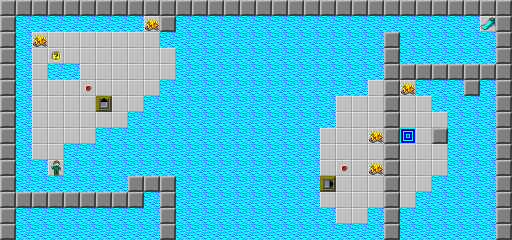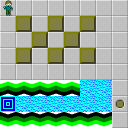Rule of double bridges: Difference between revisions
No edit summary |
Tylersontag (talk | contribs) m (Tylersontag moved page rule of double bridges to Rule of double bridges over redirect: revert) |
| (One intermediate revision by one other user not shown) | |
(No difference)
| |
Latest revision as of 17:08, 27 February 2019
The Rule of double bridges is a principle of block pushing concerning maximized efficiency of building a double bridge. A double bridge is classified as any two water spaces next to each other being built at the same time. The goal of the rule is to determine when and where the dirt should be removed, and the quickest way to build the bridges.
Usually, the rule of double bridges is applied to pools of water such as this, from a level called Rock Pool:
Ignoring the gliders that are also in this level, the goal of Rock Pool is to either build from one island to another, eventually reaching the exit, or to get to the flippers and swim to the exit. The flippers take longer to reach, but in the end they are the quicker route, with a time of 821 recorded through the level out of the time limit of 999.
Build across to the second island, then clone one block and move it 2D L, then go back 3U D and step over the dirt, and move the block R 7U into the water. The remainder of the block pushing is building 4U across both columns and then 6R to the flippers. The rule of double bridges states that when confronted with a situation such as this, build spaces alternately, and start with the bridge further from the intended target (or, also, closer to the majority of the supply of blocks), in this case the one on column 22. Do not touch the dirt, but instead remove it on the way back from building on the bridge to the right.
Continue this until you prepare to come to the turn. This time, build on column 23 first, then move the next block into the space left behind, which allows Chip to then use this block directly after finishing column 22, following the rule of turning bridges. The remainder of the level is building to the flippers, and then swimming to the exit.
The other side of the rule of double bridges is when there is a supply of blocks, and two adjacent bridges of any length, even simply one square:
This is the rule at its simplest. Move block 5 D and block 8 2D to the water, then move block 7 D and use the rule of double bridges for block 5. To use the rule of turning bridges, move blocks 7 and 3 onto [5, 5], then move blocks 6, 4, and 2 R and continue block 2 2R 5D. Finish with the remaining blocks.
Each application of the rule of double bridges saves 2 moves. Generally, the requirements needed to move a block to either of the bridges will be identical no matter which side is begun first, but sometimes it will not. Use the rule judiciously; if more than two moves are lost by beginning the nearer side first, obviously build as normal.
Typically, anywhere the rule of turning bridges is seen will also allow the use of the rule of double bridges. Levels where this can be used include the No boost route to Castle Moat, On the Rocks, and Cake Walk.

